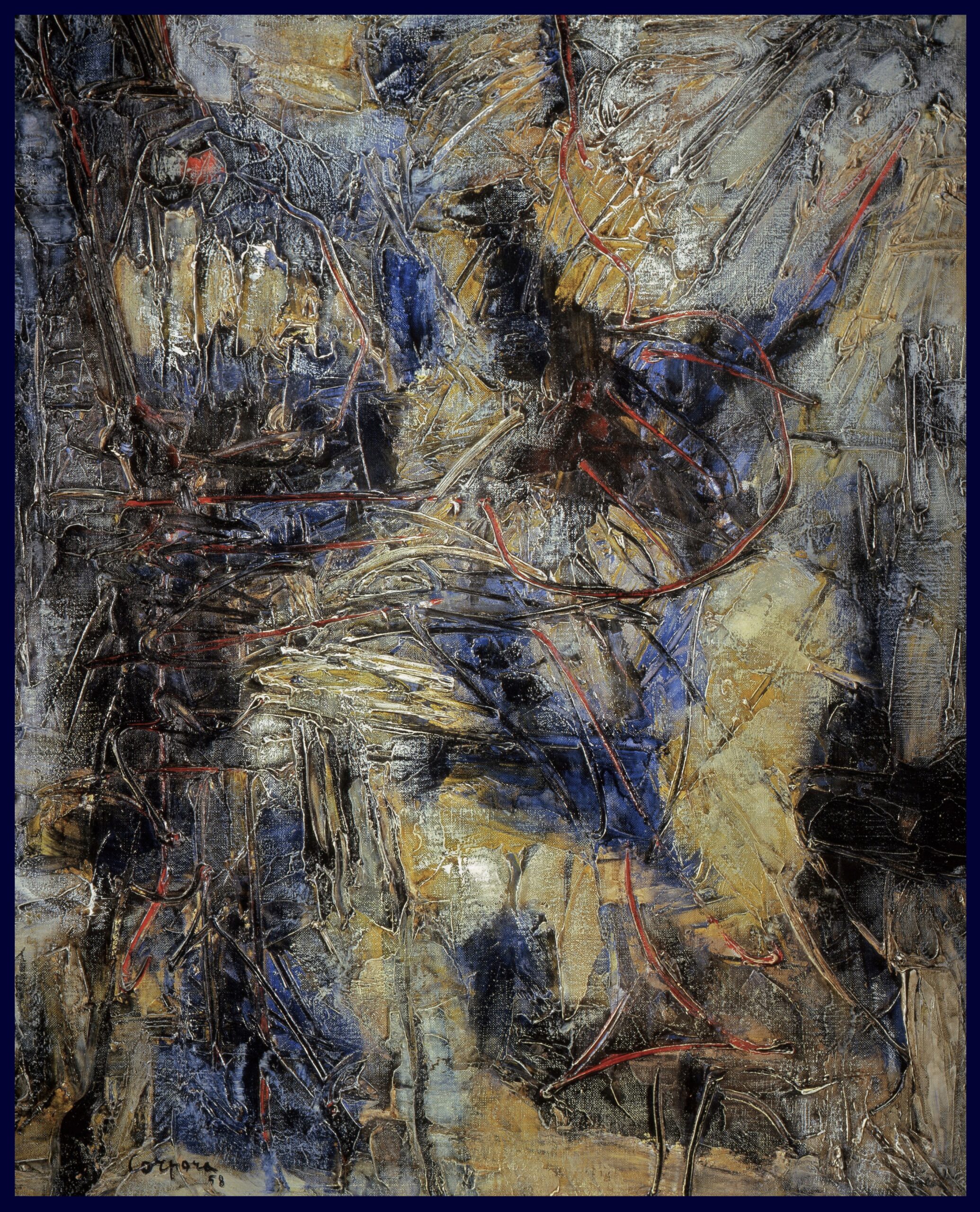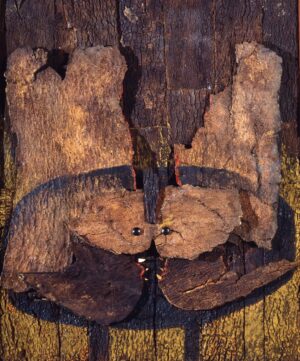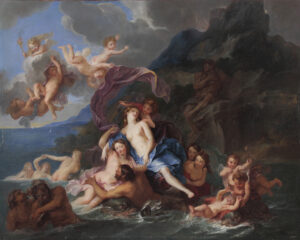Antonio Corpora
Tunis 1909 - Rome 2004
“Footprints on the Stone” 1958 Oil painting on canvas.
100 x 80 Origin: La Bussola Gallery, Rome.
"Label on the back" Private Collection New York.
Kleemann Galleries New York 1959.
Chalette Gallery in New York 1962.
Publications:
Lionello Venturi - Klemann Galleries New York “Antonio Corpora“ April 1960, exhibition catalog.
La Bussola Gallery, Rome. "Label on the back"
Work accompanied by an authentication on photograph by Giovanni Di Summa dated 2016 and bearing the following note: "N.B. Exceptional work, a splendid American period, with exhibitions from 1958 to 1962 in New York, by Kleeman Galleries and Chalette Gallery.
Born in Tunis in 1909 from parents of Sicilian origin, in 1928 he attended the Academy at the "Ecole des Beaux Arts" of his city. In 1929 he was in Florence, where he attended the lessons of Felice Carena at the Academy and copied the works of the great masters in the Museums and in 1930, not finding himself in a moment with the Florentine cultural conservative climate, he moved to Paris. Here he completed his artistic training, in a cultural climate influenced by the great post-impressionist, cubist and 'fauves' schools, and very different from the contemporary Italian one, dominated by the twentieth century. However, he continues to travel and maintains links with Tunisia and Italy; he met Carlo Belli and came into contact in 1934 with the abstract artists gathered around the Galleria del Milione in Milan, such as Fontana, Reggiani, Soldati. In 1945 and he was in Rome, the initial guest of Renato Guttuso's studio, he participated, with his works and various writings, in the lively cultural climate of those years immediately after the war. Due to his first-hand training in the French painting of the 20th century, unique among the artists of the time, he fought, together with others, in favor of a renewal of the Italian pictorial language in a European sense.
In 1946 he promoted a "neo-cubist" exhibition with Guttuso in Rome and subsequently participated in the establishment of the New Front of the Arts, with which he participated in his first Venice Biennale in 1948. In 1952 Lionello Venturi, at Corpora's request, agrees to write a short text for a publication presenting the Group of Eight (Afro, Birolli, Corpora, Moreni, Morlotti, Santomaso, Turcato, Vedova). In the mid-fifties, Corpora is now an established protagonist of the Italian and European art scene. His painting gradually began to dissolve Cubist geometries, following a path common to that of other exponents of the "Eight" and other European artists. His exhibition activity is very intense; after the experiences of '48, '50 and '52, he will then be present at the Biennale, with a personal room, also in 1956, 1960, 1966. In 1954 he won a purchase prize at the second edition of the Spoleto Prize. Among other personal exhibitions of those years, he is in 1957 at the Galleria La Tartaruga in Rome, in 1959 at the Galleria Blu in Milan, in 1960 at the Galleria Pogliani in Rome. On an international level, Corpora participates in Documenta 1 in Kassel in 1955 and in Documenta 2 in 1959, and holds a solo show in 1958 at the Galerie Springer in Berlin. In Paris, in 1957 he is at the Cahiers d'art Gallery; for the occasion Christian Zervos [14] publishes a monograph on Corpora with its own introduction. He exhibited in New York at the Kleemann Galleries in 1958 (presented in the catalog by Venturi) and in 1960 (presented by Nello Ponente), and at the Galerie Chalette in 1962 (presented by Argan); some works enter the collections of American museums, such as the Museum of Modern Art in New York In the works of recent years, such as our 1958 “Footprints on the Stone”, Corpora dialogues with the European informal, abandoning any sense of geometric construction; the colors tend to darken and are given in thick strokes and scratches with the back of the brush, giving free rein to the visceral and lyrical abstractionism that characterizes some works of this period. S.L.
---------------------------------------------------------------------------------------------------------------------------------------------------------------
Antonio Corpora
Tunisi 1909 – Roma 2004
“Impronte sulla Pietra” 1958
Olio su tela . 100 x 80
Provenienza:
Galleria La Bussola, Roma . “Etichetta sul retro”
Collezione Privata New York.
Kleemann Galleries New York 1959.
Chalette Gallery New York 1962 .
Pubblicazioni:
Lionello Venturi – Klemann Galleries New York “ Antonio Corpora “ aprile 1960 , catalogo della mostra.
Galleria La Bussola, Roma . “Etichetta sul retro”
Opera corredata da un’autentica su fotografia di Giovanni Di Summa datata 2016 e recante la seguente nota:”N.B. Eccezionale opera, periodo splendido americano, con mostre dal 1958 al 1962 a New York, da Kleeman Galleries e Chalette Gallery.
Nasce a Tunisi nel 1909 da genitori di origine siciliana, nel 1928 frequenta l’Accademia all'"Ecole des Beaux Arts" della sua città.
Nel 1929 si stabilisce a Firenze, ove frequenta le lezioni di Felice Carena all'Accademia e copia le opere dei grandi maestri nei Musei e nel 1930 non trovandosi a agio con il clima culturale conservativo fiorentino si trasferisce a Parigi.
Qui completa la sua formazione artistica, in un clima culturale influenzato dalle grandi scuole post-impressioniste, cubiste e 'fauves', e molto diverso da quello italiano coevo, dominato dal Novecento.
Continua però a viaggiare e mantiene legami con la Tunisia e l'Italia; incontra Carlo Belli ed entra in contatto nel 1934 con gli astrattisti raccolti attorno alla Galleria del Milione di Milano, come Fontana, Reggiani, Soldati.
Nel 1945 e si stabilisce a Roma, ospite inizialmente dello studio di Renato Guttuso, partecipa, con le sue opere e con vari scritti, al vivace clima culturale di quegli anni dell'immediato dopoguerra.
A causa della sua formazione di prima mano della pittura francese del '900 unica tra gli artisti dell'epoca si batte, assieme con altri, in favore di un rinnovamento del linguaggio pittorico italiano in senso europeo.
Nel 1946 promuove con Guttuso a Roma una mostra "neo-cubista" e successivamente partecipa alla costituzione del Fronte nuovo delle arti, con il quale partecipa alla sua prima Biennale di Venezia nel 1948.
Nel 1952 Lionello Venturi, su richiesta di Corpora, accetta di scrivere un breve testo per una pubblicazione che presenta il Gruppo degli Otto (Afro, Birolli, Corpora, Moreni, Morlotti, Santomaso, Turcato, Vedova).
A metà degli anni cinquanta, Corpora è ormai un protagonista affermato della scena artistica italiana ed europea. La sua pittura inizia progressivamente a sciogliere le geometrie cubiste, seguendo un percorso comune a quello di altri esponenti degli "Otto" e di altri artisti europei. La sua attività espositiva è molto intensa; dopo le esperienze del '48, del '50 e del '52, sarà poi presente alla Biennale, con sala personale, anche nel 1956, 1960, 1966.
Nel 1954 vince un premio acquisto alla seconda edizione del Premio Spoleto. Tra le altre personali di quegli anni, è nel 1957 alla Galleria La Tartaruga di Roma, nel 1959 alla Galleria Blu a Milano, nel 1960 alla Galleria Pogliani a Roma. A livello internazionale, Corpora partecipa a Kassel a Documenta 1 nel 1955 e a Documenta 2 nel 1959, e tiene una personale nel 1958 alla Galerie Springer di Berlino. A Parigi, nel 1957 è alla Galleria Cahiers d'art; per l'occasione Christian Zervos[14] pubblica una monografia su Corpora con una propria introduzione. Espone a New York alla Kleemann Galleries nel 1958 (presentato in catalogo da Venturi) e nel 1960 (presentato da Nello Ponente), ed alla Galerie Chalette nel 1962 (presentato da Argan); alcune opere entrano nelle collezioni dei musei americani, come il Museum of Modern Art di New York
Nelle opere di questi anni come ad esempio la nostra “Impronte sulla Pietra” del 1958 Corpora dialoga con l'informale europeo abbandonando ogni senso di costruzione geometrica; i colori tendono a scurire e sono dati in spesse pennellate e graffi con il retro del pennello, dando libero sfogo all’astrattismo viscerale e lirico che caratterizza alcune opere di questo periodo.
S.L.





Recensioni
Ancora non ci sono recensioni.